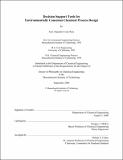Decision support tools for environmentally conscious chemical process design
Author(s)
Cano Ruiz, José Alejandro, 1969-
DownloadFull printable version (15.81Mb)
Other Contributors
Massachusetts Institute of Technology. Dept. of Chemical Engineering.
Advisor
Gregory J. McRae.
Terms of use
Metadata
Show full item recordAbstract
The environment has emerged as an important determinant of the performance of the modern chemical industry. Process engineering in the 21st century needs to evolve to include environmental issues as part of the design objectives, rather than as constraints on operations. A frequently cited objection to the use of quantitative indicators of environmental performance in product and process design is that the underlying data are too uncertain for the numbers to have any real meaning. This thesis demonstrates that explicit incorporation of uncertainties allows bounds to be established on the confidence of decisions made on the basis of uncertain indicators. The examples provided show that large uncertainties in indicators used to assess environmental performance do not necessarily imply uncertainty in decision-making. A series of computer-aided decision making tools have been developed to decrease the barriers to the use of environmental valuation functions in routine design activities. These tools include: uncertainty propagation of relative performance measures, a spreadsheet-based fate, transport and exposure model for chemicals, an information content chart for assessing the quality of uncertain indicators, a screening procedure to identify the most important structural and parametric uncertainties in multimedia exposure models, a process by product input-output life cycle assessment method to generate correlated distributions of unit environmental indicators, an extension of the deterministic equivalent modeling method for the generation of spreadsheet based polynomial chaos expansion metamodels of process flowsheet models, and a database for managing uncertain parameters used in environmental valuation models. Case studies are presented to help the reader in learning the use of the tools. The tools are also applied to an analysis of the U.S. toxics release inventory, in which confidence bounds are developed for the trends in impacts and the contributions of industrial sectors and specific chemical compounds to overall potential impact. Although the tools were developed bearing in mind the need for methods to evaluate the environmental performance of chemical process design alternatives, the ideas can be applied to any decision context in which there are significant uncertainties in the parameters of the objective function.
Description
Thesis (Ph.D.)--Massachusetts Institute of Technology, Dept. of Chemical Engineering, 1999. Electronic version available online. "September 2000." Includes bibliographical references. This electronic version was submitted by the student author. The certified thesis is available in the Institute Archives and Special Collections.
Date issued
1999Department
Massachusetts Institute of Technology. Department of Chemical EngineeringPublisher
Massachusetts Institute of Technology
Keywords
Chemical Engineering.